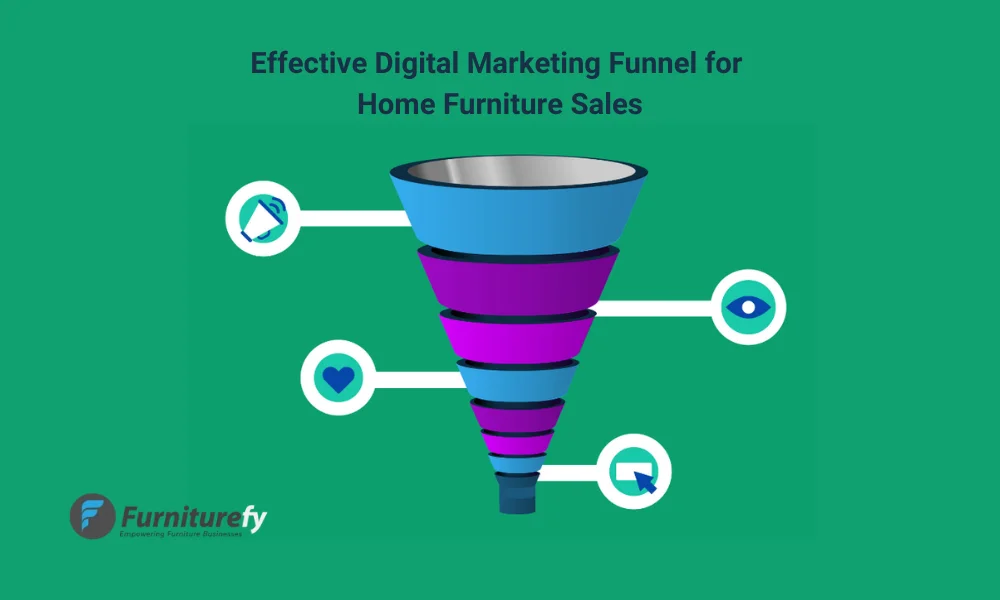In today’s competitive home furniture market, having a clear digital marketing funnel for furniture sales is essential to turn interested browsers into loyal buyers. This funnel is like a step-by-step journey, moving potential customers from first discovering your brand to making a final purchase. We’ll break down each stage of the funnel, sharing simple and effective tips to boost engagement, increase sales, and build lasting customer loyalty. Whether you’re new to digital marketing or looking to improve your strategy, these insights will help you make every stage of the funnel count.

Below are the techniques through which you can create an effective digital marketing funnel for the home furniture sales.
Awareness Stage: Attracting Potential Buyers
The awareness stage is the first step in drawing people to your brand. This stage should focus on reaching a wide audience and increasing visibility.
- SEO-Optimized Content: Develop SEO-friendly blog posts and visual content targeting keywords like “modern furniture trends” or “best sofas for small spaces.” These are great for attracting traffic from search engines and boosting brand visibility.
- Social Media Ads: Utilize platforms like Instagram and Pinterest, where visually appealing ads resonate well with users. Carousel ads and shoppable posts are particularly effective in showcasing a range of products.
- Influencer Partnerships: Collaborate with home decor influencers who can introduce your brand to their audiences. Influencer content can bring in followers actively searching for furniture recommendations.
Interest Stage: Engaging and Educating Prospects
Once prospects are aware of your brand, the next step is to engage them and build interest in your products.
- High-Quality Product Pages: Make sure your product pages are detailed, with descriptions covering each product’s materials, unique features, and styling options. Include high-quality images and videos for an immersive shopping experience.
- Email Marketing: Collect email addresses via lead magnets, such as a downloadable decor guide or exclusive discount. Use email sequences to share product information, styling inspiration, and updates on new arrivals.
- Virtual Showrooms and AR: Offering virtual reality (VR) showrooms or augmented reality (AR) tools allows potential buyers to visualize furniture in their own space, which can greatly increase engagement.
Consideration Stage: Nurturing and Building Trust
In the consideration stage, prospects evaluate your brand and products in more detail. This is where trust-building becomes essential.
- Customer Reviews and Testimonials: Display verified reviews and testimonials on product pages to build confidence. Many shoppers look for these as a trust signal when deciding on high-ticket items.
- Comparison Guides and Buyer’s Tips: Provide useful resources like comparison charts and buying guides that help customers make informed choices. This type of content is particularly valuable for buyers who are torn between similar products or styles.
- Retargeting Ads: Use retargeting ads to keep your brand top-of-mind for users who have visited your site but haven’t yet made a purchase. Tailor the ads to show the exact items they previously viewed or offer a small discount.
Conversion Stage: Turning Interest into Sales
The conversion stage is focused on turning potential customers into buyers. This stage is all about providing a seamless and compelling purchasing experience.
- User-Friendly Checkout: Simplify the checkout process. Ensure it’s optimized for mobile and offers various payment options like digital wallets, which are increasingly popular.
- Limited-Time Offers and Discounts: A sense of urgency can be effective in driving conversions. Try tactics like “Limited Stock” banners or flash sales to encourage action.
- Abandoned Cart Recovery: Send reminder emails to users who left items in their cart. A well-timed email with a slight incentive, such as a small discount, can bring them back to complete the purchase.
Retention Stage: Encouraging Repeat Purchases
- The retention stage focuses on keeping customers engaged after they’ve made a purchase. This is essential for maximizing the value of each customer.
- Loyalty Programs: Introduce a rewards system where customers can earn points or discounts on future purchases. Loyalty programs encourage repeat purchases, especially important in the furniture industry.
- Post-Purchase Follow-Ups: After a sale, send a follow-up email thanking the customer and requesting a review. You can also include care instructions or styling tips specific to their purchase.
- Cross-Selling and Upselling: Use previous purchases to make personalized recommendations for matching decor or accessories, which can lead to additional sales.
Advocacy Stage: Turning Customers into Brand Ambassadors
The final stage, advocacy, aims to transform satisfied customers into brand advocates who will share their experiences and recommend your brand to others.
- User-Generated Content (UGC): Encourage customers to share photos of their furniture on social media. Reposting their content is a powerful form of social proof and builds a sense of community around your brand.
- Referral Program: Create a referral program where customers can earn rewards or discounts by introducing friends and family to your brand.
- Shareable Content: Publish engaging content, such as seasonal lookbooks or style guides, that customers can share. This is an effective way to reach potential buyers through recommendations from trusted sources.
Conclusion
Building an effective digital marketing funnel for home furniture sales requires a strategic approach at every stage—from attracting leads to nurturing them and finally turning them into loyal customers. By implementing the latest trends and focusing on personalized engagement, you can drive sales, create meaningful customer connections, and achieve sustainable growth for your furniture business.
Read more : How to Boost Your Brand Visibility at the January Furniture Show
FAQs
A digital marketing funnel is a structured process guiding customers from awareness to purchase and beyond. For home furniture sales, it’s essential as it creates a step-by-step journey, helping brands nurture leads, build trust, and drive conversions.
Use high-quality visuals and targeted ads on social platforms like Instagram and Pinterest. Collaborating with influencers and focusing on SEO can also increase visibility, making your brand more recognizable.
AR tools allow customers to see furniture in their own spaces, making it easier to visualize products and increasing purchase confidence. With more buyers expecting such options, it can be a worthwhile investment.
Loyalty programs encourage repeat purchases by rewarding customers for their commitment. This can be particularly effective in building long-term relationships, especially as furniture is a higher-consideration purchase.
User-generated content showcases real customer experiences, providing social proof and fostering trust. It creates a community feeling around the brand, increasing credibility and encouraging new customers to engage.

Alex Mitch
Welcome to my blog! With over 10 years in digital marketing, I’ve seen its incredible impact on smaller businesses. Join me as we explore how digital marketing can grow your audience and boost your business. Whether you’re an experienced entrepreneur or just starting out, you’ll find practical tips and insights to enhance your digital marketing strategies.





